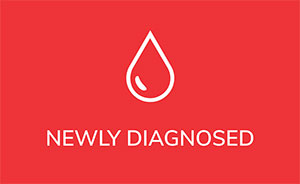Reviewed by Dr. Brian Koffman
CLL is a leukemia, but what is leukemia? This article is a zooming out from chronic lymphocytic leukemia to help understand it in its broader context with other blood cancers.
Leukemia is a broad term for cancers of the blood cells and blood-forming tissues. The diagnosis is usually made when the cancerous cells are found in the peripheral bloodstream. In leukemia, the bone marrow or the lymphatic system makes large numbers of abnormal cells which crowd out and/or suppress the growth of the healthy cells in your bone marrow and blood. This prevents your cells and blood from functioning normally. There are many different types of leukemia, including chronic lymphocytic leukemia (CLL). The type of leukemia depends on the type of blood cell that becomes cancer and whether it grows quickly or slowly.
Leukemias are in a different disease classification than lymphomas and myeloma, which are also types of blood cancers.
Acute leukemias appear suddenly and grow quickly over a short period of time. For example, someone could be perfectly fine at their annual physical and then be diagnosed with leukemia a few months later. These types of leukemia almost always get worse quickly if not treated and can be quickly fatal. Acute leukemia can be a hematologic emergency needing urgent treatment within days of diagnosis. The good news is they can be curable, especially in children.
Chronic leukemias grow much more slowly and occur mostly in adults. These leukemias are usually found when people are being tested for something else or have recurring infections or abnormal blood work. Sometimes, there may be no symptoms (especially in young patients), so the diagnosis may be unexpected. Chronic leukemias usually get worse over a long period of time, and there is usually time to formulate a plan. They are, by definition, indolent or slow-moving but are rarely curable.
Leukemias are then further categorized by the kind of white blood cell involved: either lymphocytes (a type of white blood cell that is found in the blood and that arise from the bone marrow and/or lymphatic tissues such as lymph nodes and the spleen) or myeloid cells (bone marrow stem cells that can become white blood cells, red blood cells, or platelets).
Some Examples of Chronic Leukemias
- Chronic lymphocytic leukemia (CLL) is the most common leukemia in adults and tends to occur in middle age or later. When there are less than 5,000 cancer cells per microliter of blood, it is small lymphocytic lymphoma (SLL) and is classified as lymphoma, not leukemia. Still, it’s best thought of as different stages of the same genetically identical disease. You can learn more about the naming difference between CLL and SLL here. CLL is a cancer of white blood cells, specifically the B cells responsible for making antibodies. Typically, CLL is slow-growing, and most patients do not have symptoms at diagnosis. CLL is often unexpectedly discovered on a routine blood test for an unrelated problem. About 5-10% of patients have symptoms of CLL at the time of diagnosis, including severe fatigue, unexplained weight loss, fever, night sweats, or enlarged lymph nodes.
- Chronic myeloid leukemia (CML) is rare and tends to occur in adults during middle age or later. People with CML have a genetic change called the Philadephia chromosome, where some DNA from one chromosome fuses with another. This genetic change is the target of the world’s first oral kinase inhibitor for blood cancer, imatinib, which changed CML from a fatal disease to a chronic condition with a normal life expectancy for many. Untreated, the abnormal genetic fusion causes too many blood stem cells to become abnormal granulocytes, a type of white blood cell that crowd out the healthy white blood cells.
- Myelodysplastic syndromes (MDS): Think of MDS as a form of bone marrow failure. It happens when the bone marrow produces too many immature blood cells, causing a shortage of normal blood cells that might include alone or in combination platelets, red blood cells, and neutrophils. It is more common in those with prior chemotherapy for a solid tumor or other blood cancers, including CLL. MDS is very variable in its course and can be life-threatening, requiring frequent transfusions
- Myeloproliferative neoplasms (MPN): This family of myeloid blood cancers is treated with oral chemotherapy. MPN can devolve into AML, which is very aggressive (see below).
- Aplastic anemia is a stem cell disorder where the bone marrow stops making stem cells. Some medications can induce it and can be helped by removing the offending drug and treating it with chemo and immunotherapy.
- Hairy cell leukemia is a rare form of chronic leukemia that only affects about 1,000 people a year. It responds well to a combination of rituximab and cladribine (similar to fludarabine).
- Chronic Myelomonocytic Leukemia (CMML): This is its subtype in the MDS/MPN area that, while variable, tends to have a poor prognosis.
The Two Most Common Acute Leukemias
- Acute lymphocytic leukemia (ALL) is the most common type of cancer in children, although adults can develop it too, and it is relatively rare. Most children are cured after treatment, but this is less likely in adults. In ALL, the body produces too many abnormal white blood cells, crowding out healthy white blood cells, red blood cells, and platelets.
- Acute myeloid leukemia (AML) is commonly diagnosed in adults 60 or older. In AML, the myeloid stem cells, which produce red blood cells, platelets, and granulocytes, become cancerous. It is a very aggressive cancer that is hard to treat and can result from chemotherapy used to treat other cancers, including CLL.
While many types and subtypes of leukemia are important, as getting the correct diagnosis can lead to the appropriate treatment, the big four common leukemias are CLL, CML, ALL, and AML.
Take care of yourself first.
Ann Liu, PhD

















